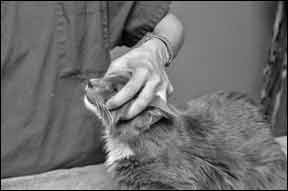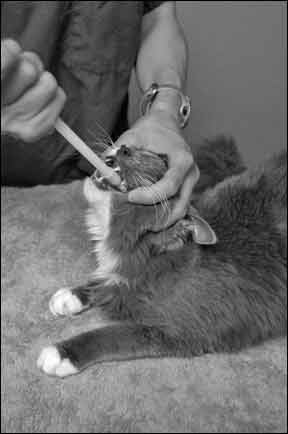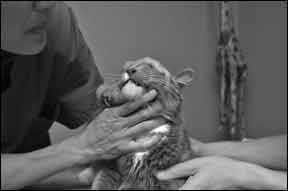You sigh with relief after the veterinarian examines your ailing cat and tells you that he’ll make a complete recovery. But then the veterinarian brings out a bottle of pills and begins giving you instructions on administering the right dose each day. Suddenly, you panic as you envision a struggle between you and your cat about pills or potions.

288
It doesn’t have to be that way. Giving medicine can be easily accomplished by performing the correct steps in the right sequence; and here to help you master that procedure are Margaret Schnellinger, Licensed Veterinary Technician and LVT Team Leader at the Cornell University Hospital for Animals, and behaviorist Sophia Yin, DVM, in private practice in Davis, Calif. Dr. Yin is also the author of “Low Stress: Handling, Restraint and Behavior Modification of Dogs & Cats” (CattleDog Publishing), a resource with more than 1,600 how-to photographs for veterinarians and veterinary technicians.

288
“There’s a reason a given medication is prescribed for a certain amount of time,” Schnellinger says. “Depending on the medication, it takes a certain amount of time for the drug to establish certain levels in the bloodstream to do its job and to stay at that level long enough to make sure the problem doesn’t recur. If treatment is shortened because owners may think that their cat is doing better, they may risk the problem not resolving or recurring.”
The first step when giving medicine is being in the right mindset. Remind yourself that you’re a vital player in your cat’s recovery. Before reaching for the medicine bottle, put yourself in a patient but purposeful frame of mind. This is important because your cat can read — and respond — to your emotional state.
Don’t Force it. “The idea of trying to force a pill into your cat’s mouth is not always comfortable for either you or your cat,” Dr. Yin says. “Some cats are difficult to ‘pill’ because they don’t like being restrained or having their mouths opened, or the pill does not taste good to them. Also, cats have shorter faces than dogs, so you can’t control them by holding their muzzles.”

288
Depending on the medicine, you may have options. Ask your cat’s veterinarian if the three-times-a-day dose can be converted to one time a day or if you can split the pill for easier swallowing, or use a pill gun or pulverize the pill without compromising its effectiveness.
Whatever the form of the medicine you use, always select a location — a small, confined space — to prevent feline escape. A bathroom is ideal because you can close the door. Body positioning is also crucial. Place your cat so that his rear is against a wall so he won’t wriggle away. And before you give the medicine, have the tools you need ready. These include a syringe with water or tuna juice, canned tuna or favorite treat and possibly a pill gun. These inexpensive, syringe-like devices come with a plunger and soft tip.
Schnellinger and Dr. Yin offer these steps to success:
Giving a Pill
Step 1: Before attempting to “pill” your cat, prepare a syringe with one half teaspoon of water or tuna juice that will act as a chaser to ensure that the pill or capsule doesn’t get stuck in your cat’s esophagus.
Step 2: If you elect to use a pill gun, put the pill inside it. Place a tiny amount of canned cat food, tuna or other food that your cat likes on the tip of the pill gun to hide the pill.
Step 3: Place your fourth and fifth fingers behind your cat’s head to keep him from moving his head backward. Sit behind him or position him against a wall so he can’t back up.
Step 4: Tilt your cat’s head back and open his mouth. Insert the pill gun into his mouth and deposit the pill at the back of the tongue.
Step 5: Remove the pill gun and quickly close your cat’s mouth while continuing to tilt his head up. Massage his throat gently to induce swallowing. Scratch behind his ears if he likes that to make it a positive experience.
Step 6: Follow up with the water or tuna juice to ensure the pill has been swallowed. Take care to leave your cat’s head level when giving this liquid to avoid its squirting out the other side of his mouth.
Giving Liquid Medicine
If your cat needs liquid medicine, make sure you know the right dosage to avoid an accidental overdose. Check with the veterinarian about using tape or permanent marker to note the proper amount on the syringe. Again, make this a relaxed, rewarding time for your cat so he associates getting medicine with tasty treats.
Step 1: Load the syringe.
Step 2: Open your cat’s mouth, insert the syringe from the side and squirt in the liquid. Because liquids are more likely than pills to enter the trachea, keep your cat’s head level. You can also squirt the liquid medicine onto the roof of the mouth if your cat accepts having his mouth wide open.
Step 3: Remove the syringe and close his mouth so that he can’t spit out the medicine.



